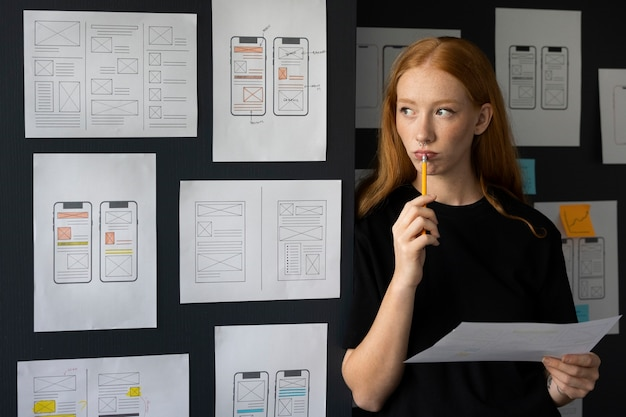The Power of Prototyping: Transforming Design Ideas into Reality
Prototyping is a crucial component of
the design process that allows designers to bring their ideas to life, test concepts, gather feedback, and refine their designs before moving into the development phase. It involves creating a tangible representation of a product or interface that simulates its functionality, interactions, and visual elements. In this blog, we will explore what prototyping is, its importance in the design process, and provide a step-by-step guide on how to effectively implement prototyping to enhance your design workflow.
What is Prototyping?
Prototyping is the process of creating a scaled-down version or representation of a product or interface to validate design concepts, gather user feedback, and make informed design decisions. It allows designers, stakeholders, and users to interact with and experience the design in a tangible and interactive manner before investing significant time and resources in development.

Prototypes can vary in fidelity, ranging from low-fidelity sketches or wireframes to high-fidelity interactive simulations. The level of fidelity depends on the goals, complexity, and stage of the design process. Low-fidelity prototypes are typically used for early-stage exploration and ideation, while high-fidelity prototypes are employed for more detailed evaluation and testing.
Why is Prototyping Important?
Prototyping offers numerous benefits throughout the design process:
Early Validation: Prototyping allows designers to test and validate their ideas, assumptions, and design concepts early in the process. By creating interactive representations of the design, designers can gather feedback from stakeholders and users, identify potential issues, and make necessary refinements before investing in development.
Iterative Design: Prototyping enables an iterative design approach where designers can quickly refine and evolve their concepts based on user feedback and testing results. It facilitates a feedback loop that promotes continuous improvement and ensures the final design meets user needs and expectations.
User-Centric Design: Prototyping helps designers focus on creating user-centered designs by providing an opportunity to observe user interactions and gather feedback firsthand. By involving users early in the process, designers can gain insights into user preferences, pain points, and usability challenges, leading to more effective and intuitive designs.
Communication and Collaboration: Prototypes serve as a communication tool to convey design ideas and intentions to stakeholders, clients, and development teams. They provide a tangible representation that aids in discussions, aligns expectations, and fosters collaboration between different stakeholders involved in the design process.
Implementing Prototyping in the Design Process
To effectively implement prototyping in your design process, follow these steps:
Define Objectives and Scope: Clearly define the objectives of your prototype and its scope. Determine the specific questions you want to answer or the design aspects you want to validate through the prototyping process.
Identify Key Interactions: Identify the core interactions and functionality that need to be simulated in the prototype. Focus on the most critical aspects of the design that will have the greatest impact on the user experience.
Choose the Right Fidelity: Select the appropriate fidelity level for your prototype based on your objectives and stage of the design process. Low-fidelity prototypes, such as sketches or paper prototypes, are suitable for early exploration and concept validation, while high-fidelity prototypes, created using tools like prototyping software or code, are ideal for detailed interaction testing and evaluation.
Create a Flow or Storyboard: Map out the user flow or storyboard that represents the sequence of interactions and screens within your prototype. This will help you organize your design elements and establish the logical progression of user interactions.
Design and Build: Start designing and building your prototype, focusing on accurately representing the key interactions, interface elements, and visual design. Utilize design tools or prototyping software to create interactive elements, transitions, and animations that mimic the intended functionality.
Test and Gather Feedback: Conduct user testing sessions to observe how users interact with your prototype. Encourage users to provide feedback on the usability, intuitiveness, and overall experience. Capture their insights and identify areas for improvement.
Iterate and Refine: Based on the feedback and insights gathered from user testing, iterate on your prototype and make necessary refinements to enhance its usability and effectiveness. Repeat the testing and iteration process until you achieve a design that meets user needs and aligns with your objectives.
Collaborate and Communicate: Share your prototype with stakeholders, clients, and development teams to gather their input and ensure alignment. Use the prototype as a communication tool to illustrate your design concepts, interactions, and user flows.
Document and Handoff: Document the interactions, design decisions, and key insights from the prototyping process. Provide clear instructions and guidelines for developers to ensure the accurate implementation of the design.
Test and Validate the Final Design: Once the development phase begins, continue to test and validate the implemented design to ensure it matches the intended user experience. Use the prototype as a benchmark for evaluating the final product.
Conclusion
Prototyping is an invaluable tool for designers, enabling them to validate ideas, gather feedback, and refine designs before development. By implementing prototyping in your design process and following a systematic approach, you can enhance the effectiveness of your designs, create user-centered experiences, and foster collaboration and communication with stakeholders. Embrace prototyping as an integral part of your workflow, and you’ll be well on your way to delivering exceptional designs that resonate with users and achieve your objectives.

